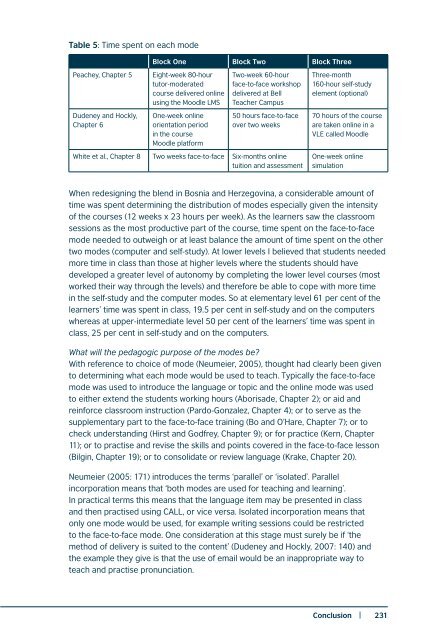Here - EnglishAgenda - British Council
Here - EnglishAgenda - British Council
Here - EnglishAgenda - British Council
You also want an ePaper? Increase the reach of your titles
YUMPU automatically turns print PDFs into web optimized ePapers that Google loves.
Table 5: Time spent on each modeBlock One Block Two Block ThreePeachey, Chapter 5Dudeney and Hockly,Chapter 6Eight-week 80-hourtutor-moderatedcourse delivered onlineusing the Moodle LMSOne-week onlineorientation periodin the courseMoodle platformTwo-week 60-hourface-to-face workshopdelivered at BellTeacher Campus50 hours face-to-faceover two weeksWhite et al., Chapter 8 Two weeks face-to-face Six-months onlinetuition and assessmentThree-month160-hour self-studyelement (optional)70 hours of the courseare taken online in aVLE called MoodleOne-week onlinesimulationWhen redesigning the blend in Bosnia and Herzegovina, a considerable amount oftime was spent determining the distribution of modes especially given the intensityof the courses (12 weeks x 23 hours per week). As the learners saw the classroomsessions as the most productive part of the course, time spent on the face-to-facemode needed to outweigh or at least balance the amount of time spent on the othertwo modes (computer and self-study). At lower levels I believed that students neededmore time in class than those at higher levels where the students should havedeveloped a greater level of autonomy by completing the lower level courses (mostworked their way through the levels) and therefore be able to cope with more timein the self-study and the computer modes. So at elementary level 61 per cent of thelearners’ time was spent in class, 19.5 per cent in self-study and on the computerswhereas at upper-intermediate level 50 per cent of the learners’ time was spent inclass, 25 per cent in self-study and on the computers.What will the pedagogic purpose of the modes be?With reference to choice of mode (Neumeier, 2005), thought had clearly been givento determining what each mode would be used to teach. Typically the face-to-facemode was used to introduce the language or topic and the online mode was usedto either extend the students working hours (Aborisade, Chapter 2); or aid andreinforce classroom instruction (Pardo-Gonzalez, Chapter 4); or to serve as thesupplementary part to the face-to-face training (Bo and O’Hare, Chapter 7); or tocheck understanding (Hirst and Godfrey, Chapter 9); or for practice (Kern, Chapter11); or to practise and revise the skills and points covered in the face-to-face lesson(Bilgin, Chapter 19); or to consolidate or review language (Krake, Chapter 20).Neumeier (2005: 171) introduces the terms ‘parallel’ or ‘isolated’. Parallelincorporation means that ‘both modes are used for teaching and learning’.In practical terms this means that the language item may be presented in classand then practised using CALL, or vice versa. Isolated incorporation means thatonly one mode would be used, for example writing sessions could be restrictedto the face-to-face mode. One consideration at this stage must surely be if ‘themethod of delivery is suited to the content’ (Dudeney and Hockly, 2007: 140) andthe example they give is that the use of email would be an inappropriate way toteach and practise pronunciation.Conclusion | 231

















